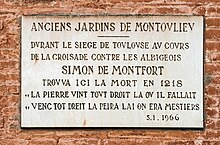Simon de Montfort, 5th Earl of Leicester
This article needs additional citations for verification. (March 2020) |
Simon de Montfort | |
|---|---|
| 5th Earl of Leicester | |
Amicia de Beaumont |
Simon de Montfort, 5th Earl of Leicester (c. 1175 – 25 June 1218), known as Simon IV (or V
Early life
He was the son of
In 1199, while taking part in a
His mother was the eldest daughter of Robert of Beaumont, 3rd Earl of Leicester. After the death of her brother
Later life
Simon remained on his estates in France before taking the cross once more, this time against Christian dissidence. He participated in the initial campaign of the Albigensian Crusade in 1209, and after the fall of Carcassonne, was elected leader of the crusade and viscount of the confiscated territories of the Raymond-Roger Trencavel family.
Simon was rewarded with the territory conquered from
Simon's part in the crusade had the full backing of his feudal superior, the King of France,
However, Philip claimed full rights over the lands of the house of St Gilles; some historians believe his dispatch of de Montfort and other northern barons to be, at the very least, an exploratory campaign to reassert the rights of the French Crown in
Simon is described as a man of unflinching religious orthodoxy, deeply committed to the
Simon was an energetic campaigner, rapidly moving his forces to strike at those who had broken their faith with him – and there were many, as some local lords switched sides whenever the moment seemed propitious. [

Raymond spent most of this period in the Crown of Aragon, but corresponded with sympathisers in Toulouse. There were rumours in September 1216 that he was on his way to Toulouse. Abandoning the siege of Beaucaire, Simon partially sacked Toulouse, perhaps intended as punishment of the citizens. Raymond returned in October 1217 to take possession of Toulouse. Simon hastened to besiege the city, meanwhile sending his wife, Alix de Montmorency, with bishop Foulques of Toulouse and others, to the French court to plead for support. After maintaining the siege for nine months, Simon was killed on 25 June 1218 while combating a sally by the besieged. His head was smashed by a stone from a mangonel, operated, according to one source, by the donas e tozas e mulhers ("ladies and girls and women") of Toulouse.[12] He was buried in the Cathedral of Saint-Nazaire at Carcassonne.[13] His body was later moved by one of his sons to be reinterred at Montfort l'Amaury. A tombstone in the south transept of the cathedral is inscribed "of Simon de Montfort".
Children
Simon and Alix had:
- Amaury de Montfort[3] married Beatrix of Viennois, died in 1241 returning from the Barons' Crusade
- Simon de Montfort, 6th Earl of Leicester[7] married Eleanor of England, killed at the Battle of Evesham on 4 August 1265
- Guy de Montfort, Count of Bigorre married Petronille, Countess of Bigorre,[7] on 6 November 1216 and died at the siege of Castelnaudary on 20 July 1220
- and died there in 1252
- Petronilla, became abbess of the Cistercian nunnery of St. Antoine's[3]
Inheritance
His French estates passed to his eldest son, Amaury, while his second son, Simon, eventually gained possession of the earldom of Leicester and played a major role in the reign of Henry III of England. He led the barons' rebellion against Henry during the Second Barons' War, and subsequently became the de facto ruler of England.
Note
- ^ The discrepancy in numbering arises from confusion between Simon III de Montfort (died 1181) and his son Simon de Montfort (died 1188). The latter was historically unknown, and Simon III was believed to be the father (not the grandfather)[1] of the subject of this article, who is therefore known as Simon IV in some sources[2] and Simon V in others.[3]
References
- ^ Cokayne, G. E. (1929). The Complete Peerage. Vol. 7 (2nd ed.). London: St Catherine Press. p. 716.
- ^ Phillips, Charles. "Battle of Toulouse". Encyclopædia Britannica Online. Retrieved 5 June 2019.
- ^ a b c Lippiatt 2017, p. xvii.
- ISBN 978-0-19-533403-6.
- ISBN 978-1-62358-003-2.
- ISBN 978-1-139-47014-8.
- ^ a b c d e Dunbabin 2011, p. xv.
- ^ Maddicott, John Robert (1994). Simon de Montfort. Cambridge: Cambridge University Press. p. 5.
- ^ Crowley, Roger (2011). City of Fortune: How Venice won and lost a Naval Empire. London: Bloomsberry House. p. 54.
- ^ Phillips, Jonathan. The Fourth Crusade and the Sack of Constantinople, 2004. p. 137.
- ISBN 0-571-20002-8.
- Chanson de la Croisade Albigeoiselaisse 205.
- Historia Albigensis615.
Sources
- Dunbabin, Jean (2011). The French in the Kingdom of Sicily, 1266–1305. Cambridge University Press.
- Lippiatt, G.E.M. (2017). Simon V of Montfort and Baronial Government, 1195–1218. Oxford University Press.
- Sumption, Jonathan. The Albigensian Crusade, 2000
- Herbermann, Charles, ed. (1913). . Catholic Encyclopedia. New York: Robert Appleton Company.
External links
 Media related to Simon IV of Montfort at Wikimedia Commons
Media related to Simon IV of Montfort at Wikimedia Commons
